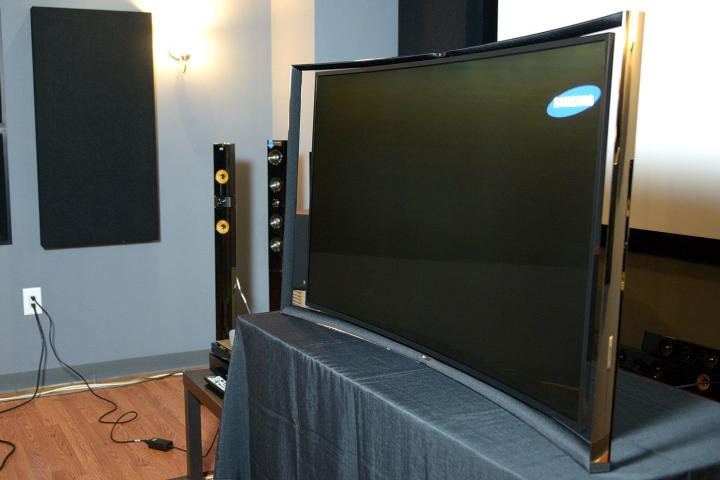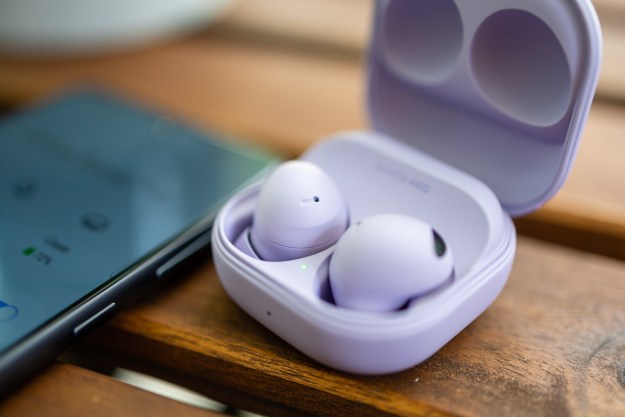
LG and Samsung have generated significant buzz since introducing their OLED televisions in the US. For the media, much of that chatter has centered around the TV’s outstanding performance. But among the public, it would seem questions are fixated one one element: the curve. Why are these TV’s curved? What is the point of a curved OLED TV? Are we going to get flat-screen OLEDs this year, too?
…there’s a tremendous amount of pressure – some of it self-imposed – to out-innovate the competition.
First, here are the official statements from both manufacturers. LG states: “The curved screen looks wider and delivers a more realistic experience free of image distortion, regardless of where you look. LG spent more than five years researching the optimal curvature for the best experience, bringing an IMAX-like viewing experience to the home.’
Samsung, on the other hand, made this statement: “Our new 55” OLED TV is curved because we wanted to offer a very special experience. The “Timeless Arena” design draws viewers into the picture and gives videos a presence not felt on flat screens. It also helps distinguish the OLED technology from other TVs at retail.”
While both companies make a point to outline the proposed viewing benefit, Samsung does touch on some other elements, but fails to really spell them out in a meaningful way.
I’ve already stated in reviews of both televisions that I don’t feel the curved screen succeeds at imparting a more realistic or immersive experience. But I’ve also been quick to point out that it doesn’t take anything away from the experience, either. Off-axis viewing is no worse (and, in some cases, is actually better) than most LCD-based TVs I’ve evaluated. And I never felt like the image was unusually distorted when viewed from reasonable angles, either. Had an enhanced viewing experience been the sole motivation for creating a curved TV, you could see this effort as a failure. But as I’ve already stated, there are other motivating factors at play here.
The reality is that neither Samsung nor LG is going to sell very many of these TV’s this year, and they know that. These are expensive televisions, and yield rates are low right now, so there aren’t a whole lot of them to go around. The few that do sell are going to the homes of the wealthy, the early adopter and the occasional tech enthusiast who doesn’t mind going without a car in favor of a hot new TV. How many people do you know that could and would plop down $9,000-$15,000 on a TV? Exactly.
So, then, why not give the few consumers who do buy one of these next-gen displays something to really crow about? This isn’t just a television, this is a statement piece. Why not make that statement as grandiose and blaring as possible? So many people own flat-panel TVs now that the form’s cool-factor has lost its gravitas. How do you breath new life into a flat-screen TV? You don’t just make it thinner than its predecessors, you give it a form factor that it’s never had before. You give people something truly unique and special to own that makes them look cool – just like they wanted – and you get everyone talking about it. In the process, awareness of the technology is heightened so that when OLED TVs become plentiful and affordable enough for more people to buy them, they will.
Early adopters are like brand ambassadors for tech companies. No amount of paid print or televised advertising can match the power of an unpaid evangelist. If you can get even a small handful of influencers on board with your product, their ability to show and tell their friends will pay off in spades down the road.
Shoot for the moon
The curved OLED isn’t made for making money or pleasing a broad consumer base; it’s a Trojan horse for LG and Samsung’s brands
Why can’t we have both curved and flat?
That people are buzzing around the curved OLED proves Samsung and LG were successful in their campaigns to highlight their respective brands as leaders in technological innovation.But that doesn’t answer an obvious question: Why won’t these companies bring both curved and flat OLED TVs to the US as they have done in Korea? The over-simplified answer is: they can’t.
OLED TVs are in their infancy. OLED is a fussy technology and these TVs are difficult to make, as evidenced by the fact that they have been in some manner of prototype stage for years now. But even if they weren’t difficult to make, there would still be the challenge of scaling up production. You can’t just build an OLED TV-producing factory overnight. It takes time and a whole lot of capital to build the tooling machines and factories that will make them. And these manufacturers can’t risk going too deep into debt for the sake of ramping up OLED production. When companies get too bullish with building new factories, they risk financial backlashes. Just look at Sharp.
Faced with an either/or situation, and in consideration of the benefits that come with offering a much more unique, eye-catching product, LG and Samsung have wisely opted to bring only the curved model to the US for now. The curved OLED isn’t made for making money or pleasing a broad consumer base; it’s a Trojan horse for LG and Samsung’s brands as pioneers in next-generation displays. Flat-screen OLED TVs will come, they just won’t be coming this year. And that’s just fine, because it is highly unlikely that anyone in a position to purchase an OLED TV at this time is going to avoid buying one because it isn’t flat.
Editors' Recommendations
- I desperately crave LG’s flexible OLED TV. Here’s why I won’t buy it
- 5 TV deals you can’t afford to miss this 4th of July



